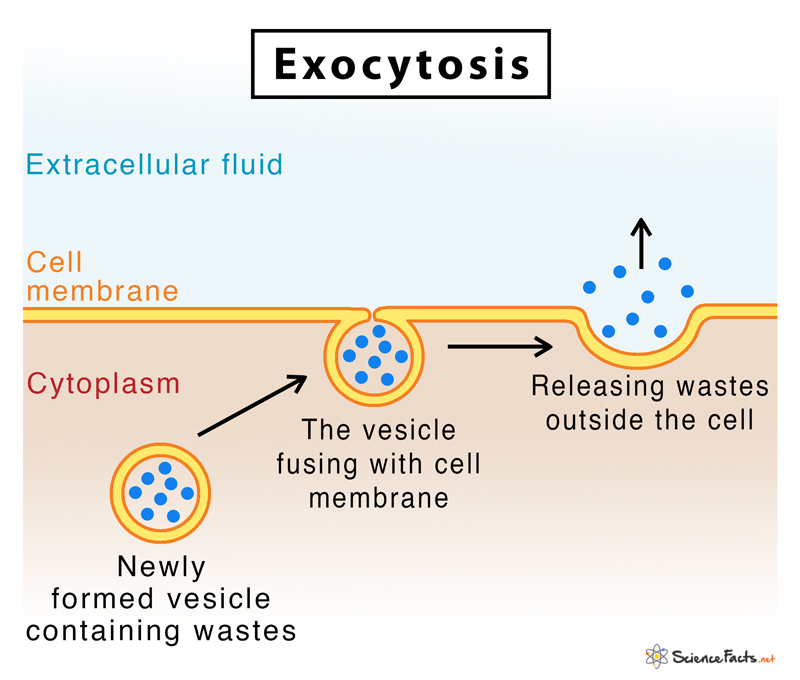Exocytosis
What is Exocytosis
Exocytosis is the natural process of transporting molecules from within a cell to the outside space. In this process, the vesicles containing the fluid enclosed by a lipid bilayer fuse with the plasma membrane to release their contents outside the cell. The term ‘exocytosis’ was proposed by De Duve in 1963.
Examples of Cells Where Exocytosis Happens
It occurs in all living cells, from invertebrates and protozoa to plants and human.
How Does it Work
The basic process starts when a membrane-bound vesicle called secretory vesicle is transported from inside the cell to the cell membrane. The vesicle then transiently fuses with the cell membrane and eventually releases its content outside the cell.
What Types of Materials are Expelled from Cells During Exocytosis
Large and complex protein molecules like enzymes, peptide hormones, and antibiotics are regularly released through this energy-dependent process.
Steps Involved in Exocytosis
The entire process gets completed in the following five key steps:
Step 1: Vesicle Trafficking: The first step of exocytosis during which the secretory vesicle move from their spot of creation to the cell membrane. This is an energy-consuming step.
Step 2: Vesicle Tethering: On reaching the cell membrane, the outgoing vesicle becomes linked to, and is pulled into close contact with the cell membrane.
Step 3: Vesicle Docking: The vesicle then gets transiently attached to the cell membrane, with its own membrane beginning to merge with the latter.
Step 4: Vesicle Priming: In some cases of exocytosis, during the merging of the two membranes, the cell membrane undergoes specific modifications that further stimulate the process.
Step 5: Vesicle Fusion: This is the final step during which the process of fusion gets completed with the help of a special protein called SNARE (SNAp REceptor proteins).
What Happens to the Membrane of a Vesicle After Exocytosis
In most cases, after the completion of exocytosis, the secretory vesicle cannot be recovered in its full form to be reused, as it has permanently bonded with the cell membrane. For example, in non-constitutive exocytosis of neurons, the vesicle cannot be reused. In some other cases, such as the ‘kiss’ and ‘run’ fusion in the neurons of the hippocampus structure, the vesicle transiently attaches to the cell membrane, allowing a partial deposit of its vesicular content. The vesicle is further reused when they float back into the intracellular space only to return to the membrane for releasing the rest of its contents.
Types of Exocytosis
There are three common pathways of exocytosis occurring in different cell types; they are as follows:
- Constitutive exocytosis: Also known as the non-Ca2+ triggered constitutive exocytosis, it is performed by all body cells. This process delivers membrane proteins and lipids to the cell surface and also helps in the elimination of substances from the cell’s exterior. It is the most common mode of exocytosis.
- Regulated exocytosis: Also called the Ca2+ triggered non-constitutive exocytosis, it occurs only in the presence of extracellular signals and an increase in calcium ions. Regulated exocytosis is most common among secretory cells such as neurons, and does not occur in all cell types.
- Vesicular exocytosis: Found only in bacteria, it occurs through the involvement of lysosomes that helps in membrane-fusion. The digestive and hydrolytic enzymes of lysosomes help to break down the materials inside the vesicle, which are then released outside the cell.
Functions with Examples
1. Maintaining blood sugar level
In the pancreas, a cluster of cells called islets of Langerhans secretes the hormones glucagon and insulin. These hormones are stored within secretory granules and are released into the blood by exocytosis, thus maintaining blood sugar level. Exocytosis from other cells in the pancreas releases digestive enzymes into the gut.
2.Cell-to-cell communication
Communication between neurons through the transmission of chemical signals called neurotransmitters occurs through exocytosis. The neurotransmitters are stored in vesicles and lie next to the cytoplasmic face of the plasma membrane. When the appropriate signal is given, the vesicles having the neurotransmitters make contact with the cell membrane and secrete their contents into the space between the two neurons. This allows the adjacent neuron to receive those neurotransmitters.
3. Maintaining homeostasis
Cellular waste products or toxins are regularly removed from the cell by exocytosis. The byproducts of aerobic respiration, such as water and carbon dioxide, are also removed from the cell by exocytosis.
4. Maintaining body defense
Immune cells such as macrophages engulf foreign microorganisms such as viruses, which are then destroyed and removed through exocytosis. This prevents body cells from being infected.
Exocytosis vs. Endocytosis
Differences
| Basis | Exocytosis | Endocytosis |
| Definition | Process by which substances from within the cell are transported out | Process by which substances are brought inside the cell |
Types |
| |
Energy Usage | Use more energy than endocytosis | Use less energy than exocytosis |
Vesicle formation | Formed by fusion with the plasma membrane | Formed around the foreign particle engulfed |
Types of Vesicles | Secretory Vesicles | Similar to phagosomes |
Main Function | Releasing toxic wastes of the cell | Uptake of nutrients inside the cell |
Example | Synaptic transmission of nerve impulse in neurons | Engulfing pathogens such as virus by phagocytic cells |
Similarities
- Both are active transport mechanisms and thus require ATP, the metabolic energy of the cell
- Formation of vesicles is common to both forms of transport
FAQs
Ans. Exocytosis is an active transport processes requiring cellular energy for release of substances to and from the cell whereas diffusion is a passive transport process occurring without utilizing metabolic energy of the cell.
-
References
Article was last reviewed on Monday, October 19, 2020




